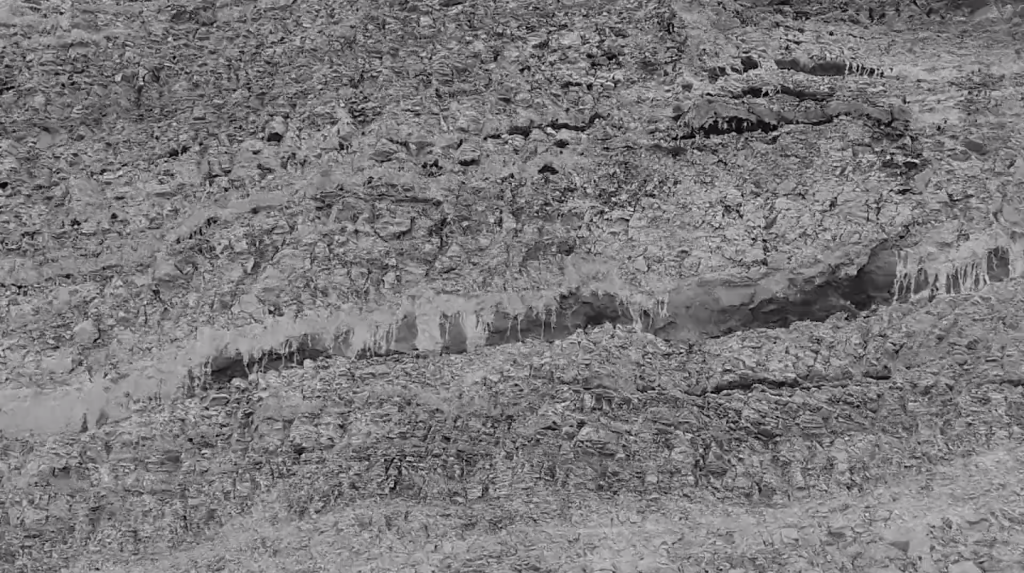
AN OPEN LETTER ON THE UNTHOUGHT CONTRADICTIONS OF DOING CLIMATE ACTIVISM
Word Count: 4,936 |
Download this article
by •
003: FALLOW
with OF THE EARTH
a video by OLIVIA JONES
In the wake of the local initiative as part of the global climate strikes in late November in Berlin, Germany, activists from a range of collectives assembled for a panel titled “How White are the New Climate Protests?” In the packed TAZ Kantine on a Tuesday evening, activists discussed, among other things, the causes of the lack of representation of racialized minorities within the German climate movement, their invisibility in mainstream media, and the need to connect local struggles to global processes in climate activism—specifically Fridays for Future (FFF) and Extinction Rebellion (XR). The effort was part of many similar ones that sought to address a range of critiques of mainstream climate activism in Germany—from BIPoC, anti-capitalist, and other positions—both online and in physical spaces.
The critiques stemmed from contestations around what the purpose of a ‘climate movement’ ought to be. For instance, a few weeks prior, in an action to create city-wide blockades in Berlin, some participants within XR Berlin had argued against using the term capitalism, allegedly so as not to alienate potential members. Similarly, activists in FFF and Students for Future at universities in Germany have debated the extent to which they should include ‘other issues’ aside from strictly ‘climate-related’ ones in their program.
It wasn’t surprising, therefore, that certain climate activists were puzzled by the framing of the event. They asked: “What does Whiteness/capitalism/inequality have to do with climate change?” In a dialogic spirit, I decided to take up both the title of the panel and the question in response thereto seriously in this essay. How might these and other, similar contradictions be generative in 1) exposing the contradictions inherent within the neoliberal Anthropocene, and 2) approaching the horizon of politics from below necessary to confront the causes of the climate crisis?
On the Friday before the UN Climate Summit in Madrid this November, an estimated four million people—many among them students—demonstrated in over a hundred places across the planet in the Global Climate Strike called by FFF and Youth Strike for Climate. During the same week, people took to the streets in the millions, in widespread protests fuelled by a range of grievances in over twenty countries, among them Iraq, Haiti, Iran, Bolivia, Chile, India, Sudan, Honduras, Hong Kong, and France. In Iran, the trigger appeared to be a hike in fuel prices. In Chile, it seemed to be a hike in metro fares. In Lebanon, the initial rallying cry was reported to be corruption in the public sector and a Whatsapp tax. Not surprisingly, there continues to be very little mention in corporate media coverage of these massive, ongoing mobilizations. When they are reported, however, they are presented as disparate events—framed as national or regional, issue-based, specific demands on the one hand, and a broad range of grievances around climate change on the other.
BUT DO THEY HAVE ANYTHING IN COMMON?
Ben Ehrenreich offered some answers in The Nation: “If you can squint past the smoke from the barricades, the commonalities start to stand out. . . . ” He argued that a range of austerity policies served as catalysts for the uprisings in the various contexts. He also emphasized the connections between the IMF, the World Bank, and various economic and political elites’ efforts to squeeze profits out of the working classes—until it boiled over—in what Ehrenreich called a “global rebellion against neoliberalism.”
More importantly, Ehrenreich sketched the relationship between neoliberalism governance and fossil fuel extractivism. He argued:
[I]t is hard not to notice that not only in Haiti but in at least half a dozen countries from Ecuador to Zimbabwe protests were sparked by increases to the price of gasoline . . . but although nearly all of these countries have been hurt by the climate crisis—and their most vulnerable citizens hurt the hardest—these fuel hikes were not about reducing emissions. The IMF frequently ties loans to cuts in energy subsidies, and fuel taxes are an easy if regressive way to defray public debt: two tactics for getting the poor, and all those who have not benefited from official corruption, to bail out those who have.
While fuel taxes owing to IMF or nationwide cuts in fuel subsidies may not have the reduction of carbon emissions as their goal, the case of France and the gilets jaunes (yellow vests) movement was a direct response to Macron’s proposal to implement a carbon tax in 2018. This was posited as a strategy aimed at the conversion away from fossil fuel consumption. As several analyses like those by Andreas Malm have demonstrated, however, the price elasticity of demand for fuel consumption is extremely insignificant in the short run. This would have meant that low-income households would have borne the brunt of the tax without any significant changes in carbon emissions. Andreas Malm remarked:
It took the gilets jaunes to shake him out of the illusion (at least for now): one cannot combat climate change by leaving the richest even freer to accumulate capital and then dump a tax on working people to nudge them, of all classes, in the right direction. That has never worked. It never will . . . Unfortunately, the illusion is still alive in the bourgeois mainstream of the environmental movement: green lobbyists assembled at COP24 [the 2018 United Nations Climate Change Conference] greeted Macron’s decision to suspend the fuel tax with dismay.
A conversion towards less carbon-intensive means of transportation, however, is indeed not only desirable, but has also been welcomed by several members of the gilets jaunes. In taking to the streets against the proposed tax, they formulated a precise critique of the bourgeois consumer-based carbon tax in the slogan: “End of the world, end of the month: same struggle.” The case of the gilets jaunes is a case in point for the contention that the failure of politics to address questions of climate change, then, is in part because of the contradictions inherent in the neoliberal Anthropocene and its attendant political-economic system. These contradictions might be identified, but may not be easily resolved.
Take the case of the Ende Gelände direct actions to shut down Germany’s largest coal mines in Northern Westphalia and the Lausitz corridor. Not only did coal workers’ unions not support their efforts, but they even actively organized against them. In Germany, a country which produces automobiles, machinery, drugs, and weapons exported to and produced through the exploitation of labor in the Global South, what might an elaborated version of the ‘same struggle’ look like? If we account for all carbon emissions originating in Germany, but also those consequences which are a result of the devastation and suffering caused by the actions of German multinationals and the European Central Bank, including the consumption of resources and the export of German waste to the Malay archipelago—what systems of energy production and consumption would need to be eliminated for carbon emissions to be meaningfully reduced?
In the cases of the recent austerity protests in Chile, Haiti, and elsewhere, protesters have taken to the streets in opposition to the crippling costs of basic needs. Interestingly, as Ehrenreich notes, many protests have continued, despite the acquiescence of authorities to their initial demands. Outcries around seemingly minor infractions suffered by the working classes has, in many places, taken the form of demands for systemic changes: in Hong Kong, from extradition to universal suffrage; in Lebanon, from corruption and price hikes to a complete political-economic overhaul; and in Chile, a replacement of the Pinochet-era constitution. Whether consciously or otherwise, many climate activists realize that nothing less than a systemic change will suffice for their long-term sustenance.
Indeed, even in FFF and XR protests in Germany, some theorizations about the links between capitalism and the climate have yielded demands for “system change not climate change” (with a range of meanings). The development of understandings of these entanglements has pushed activists to target fossil fuel industries, for example, as in the case of the Ende Gelände movement, to literally block coal mines. Recently, the Verdi Union co-organized an event at the Freie Universität in Berlin with workers of the local metro service, the BVG, and students and FFF activists. In the occupied university auditorium, participants shared visions about a socially equitable future and the role of public transportation infrastructure as a key component of the necessary systemic change.
Such arguments—those that place a transformation of the global economic system as a key element of effective climate strategy—shouldn’t come as a surprise to anyone familiar with German politics. In many spheres of society, Germany is home to various Marxist traditions, an antifascist movement, both social democratic and socialist political parties, as well as relatively widespread workers’ unions. A critique of capitalist takeover of the commons and the connection between it and the climate crisis has been made by several organizers and activists, especially in the Ende Gelände campaigns. Ende Gelände activists are considered by many to be among the most radical of climate justice movements—not just because of their analyses, but also because of their movement’s strategy and tactics, e.g., direct actions, occupations, and disruptions of production processes at coal mines, for instance.
RACE AGAINST THE ANTHROPO/S/CENE
The question of race and racism, however, has historically been a more difficult one to center in debates in social movements in Germany.
Historically, the centrality of class politics in progressive movements has often overshadowed concerns of racism, especially when it comes to questions of the global division of labor and migration. Fatima El-Tayeb has attributed this absence of an analysis of race and racism to “the ongoing myth of colorblindness” which has informed commonsense understandings of race in Germany and other parts of Europe. Europe’s inability to recognize its history of invisible racialization is an act of amnesia which denies racialized minorities a past.
One might argue that the invisibilization of race and racism in Germany also rejects the articulation of the racialized effects of politics. For years, the term racism, even in the German left, was used to refer almost exclusively to blatant racists, e.g., Nazis and neo-Nazis. The neutral term Fremdenfeindlichkeit (xenophobia) along with the term anti-Semitism remain in many discourses the two analytical tools which undermine analyses of racisms. In fact, many Germans resist using the word Rasse (race) citing its use by the National Socialists. They either use the English term race, or a substitute, for example, culture, ethnicity, heritage or nationality. However, all other ‘European Others’ and their experiences have remained untheorized in mainstream discourse. Indeed, there is almost complete amnesia in mainstream society in education, politics, and discourse around Germany’s colonial past—the brutal genocidal campaigns against the Herrero and Nama peoples in present-day Namibia, and the subsequent use of human remains and looted possessions from the colonial era in contemporary museums and research in Germany. The burden of raising the consciousness of the German public around issues of race and racism has unequally fallen on those who are most affected by them.
But the connections between ecological concerns, capitalist processes, and racism have been theorized in several forms for decades around the world. Black civil rights organizers formulated theorizations of ‘environmental racism’ in the North American context. Indigenous and Black communities throughout the Americas have developed intersectional approaches to social movements, for example, in Bolivia, Brazil, and Mexico. In India, the Chipko movements as well as the fight against constructions of large-scale dams like the Narmada dam created opportunities to critique global capital, its embeddedness in statecraft, and the salience of caste-based discrimination. In Germany, too, environmental racism has been articulated as an explanatory frame for the experiences of precarious migrants and racialized persons, and the ways that their communities disproportionately absorb the negative impacts of climate change. For instance, in a recent interview, activist Imeh Ituen of the BPoC Environmental and Climate Justice Collective Berlin outlined that the district of Neukölln has the worst air quality in Berlin. Similar urban districts with the largest share of migrant and racialized populations experience the worst effects of urban pollution. Most importantly, she argued, this is not just a result of the class positions of its inhabitants, but also the racist housing policies prevalent since the 1970s in West Berlin.
At the event in the TAZ Kantine, Ituen was one of the panelists and argued: “We cannot speak of climate justice if those who are most impacted by the effects of the climate crisis are excluded from the discussions.” Elsewhere she has emphasized the importance of centering discussions of climate change on those worst affected by its impacts, as well as the impacts of capitalism and racial discrimination, especially in the Global South, on whose backs ‘we’ live our imperial lifestyles in the Global North.
Research on the links between racism and climate change is extensive and ever-expanding. Two contributions by scholars Jedediah Purdy and Gilbert Gaul have analyzed the differentiated inequalities of the joint crises in recent publications. Their works are summarized in a recent article which noted that natural disasters make inequality worse, and geography is never an accident. Further, Noah Diffenbaugh and Michael Burke demonstrate with 90% probability that anthropogenic warming has contributed to income inequality, which will continue to be the case unless something changes.
Naomi Klein has argued at length in her books This Changes Everything and On Fire that there exists no plausible solution to the insurmountable problems caused by the climate crisis without a dismantling of capitalist processes of exploitation. She calls for urgent, deliberate political-economic approaches to combat the effects and causes of climate change, as well as its resultant crises. Similarly, Jason Moore has argued that the collective crises of ecology and inequality are a joint crisis of the commons—a crisis which can only be tackled at macro-political transnational scales, against the logic of neoliberal capitalism. Thomas Hylland Eriksen has described the history of the short twenty-first century as one determined by overheating, represented by the acceleration of what he identifies as the three crises: finance/economy, climate/environment, and culture/identity.
Initially popularized by Paul Crutzen, the Anthropocene concept has undergone several critiques and revisions. In its stead, Moore has proposed the concept of the Capitalocene to center the role of the material bases of the exploitation of fossil fuels which causes global warming. In contrast, the concept of Plantationocene seeks to shed light on the past and present of plantations, their materialities, and the economic, ecological, and political transformations they engendered, and their significance to the making of human bodies, capitalism, and land in historical perspective.
In Fossil Capital, Andreas Malm reveals the continuities in the relationship between the control of labor power—within the specific logic of capital (as opposed to economic growth as such)—and the rapid expansion of fossil fuel industries, beginning with coal mining in Britain. He named this the “fossil economy”: “The fossil economy has the character of a totality, a distinguishable entity: a socio-ecological structure, in which a certain economic process and a certain form of energy are welded together.” Kathryn Yusoff demonstrates at great length how Anthropocenic geologies continue to produce racialized effects. For instance, she proposes that “approaching race as a geologic proposition . . . is a way then to open up the imbrication of inhuman materials and relations of extraction that go beyond a place-based configuration of environmental racism as a spatial organization of exposure to environmental harm.” Slavery, then, “was a geological axiom of the inhuman in which non-being was made, reproduced, and circulated as flesh.” In the afterlives of slavery, this process continues. As Stephanie LeMenager comments, “oil literally was conceived as a replacement for slave labor.”
Francoise Verges, too, has written extensively on the exclusion of analyses of race in discussions around the Anthropocene. In supplementing Moore’s analysis of the Capitalocene to include existing debates around racial capitalism, Verges formulates the term “the racial Capitalocene.” She seeks to resurrect “the role of racialized policies of public health and toxic waste disposal, weapons and pollution, land grabs and deforestation, the importance of the Cold War with its alliance between the chemical industry and the military, laws of commerce and monopolies.” Further, she provides substantiation to the desires articulated by BPoC activists in Berlin by delineating the context in which their contestations against the apparent Whiteness of ‘new’ climate movements are iterated. She notes:
More recently, understanding what is at stake in the negotiations about ‘climate change’ means considering the place of these stakeholders in the context of a global counterrevolution—the erosion of rights, the politics of nonraciality beneath which, as David Theo Goldberg has argued, lurk more sinister shadows of the racial everyday and persistent institutional and structural racisms—and racial capitalism. Global warming and its consequences for the peoples of the South is a political question and must be understood outside of the limits of ‘climate change’ and in the context of the inequalities produced by racial capital.
Further, Verges offers a direction for future scholarship on the Anthropocene/racial Capitalocene:
We must, in our narrative of the racial Capitalocene, integrate this long memory of colonialism’s impact and the fact that destruction in the colonial era becomes visible in the postcolonial era. In other words, we must add to the United Church of Christ’s 1987 study of racialized policies of the environment in the twentieth century a history of racial Capitalocene, with an analysis of capital, imperialism, gender, class, and race and a conception of nature and of being human that opposes the Western approach.
KNOWN UNKNOWNS
If the climate crisis has more or less been accepted as truth, save for a host of denialists, why do its entanglements with racism and capitalism (along with other structural processes) not become common knowledge in mainstream climate activism, despite all the research?
There are a few obvious speculations concerning academic knowledge production specifically. The compartmentalization of knowledge in late capitalist academic production has led to the development of super-experts who focus on increasingly minute subfields within disciplinary boundaries. As a result, it has become increasingly difficult to ask larger systemic questions. Further, the atomization of individual lives and the erasure of public space has created bubbles of existence—both online and in physical space. This has ensured the severance of the pillars of critical theory—political economy, historical materialism, critical race theory, etc.—from each other through the disciplinary and social mechanisms of knowledge production.
Further, the onset of the era of identity politics has sometimes led to the rejection of any form of politics which does not conform to Euro-American bourgeois and/or orthodox understandings of class. Alternatively, mobilizations of situated knowledges—may they be racialized, queer, or gendered ones—has sometimes disturbed Euro-American academia as “White public space,” as Karen Brodkin has suggested with reference to anthropology. This, in turn, has led some bourgeois and White academics to retreat from engaging with work produced in disciplines such as ethnic and Black studies in the US, and queer theory, feminist science and technology studies, etc. in general.
This is not to suggest that there aren’t hundreds of thousands of excellent thinkers who have produced trenchant critiques, exposed the relations of power, and contributed nuanced perspectives to a variety of modes of thought—all of which are of direct relevance to confronting the complex problems of our day.
Some of the critiques of FFF in Germany, for instance, have come from activists within Germany arguing along similar lines. An open letter by Yannick Haan details why single-issue movements are not possible in an interconnected world-system, why a new collectivity and politics of collaboration and responsibility are required, and why systemic questions are essential to a climate justice project. Similarly, in an open letter to the FFF Berlin, the Latinamerican Bloc Berlin accused them of denying them the right to speak at a climate strike, and to speak directly to the concerns around the blind spots of the FFF in Berlin, for example, the ongoing social crises and the climate crisis, especially in the Global South.
My contention is, however, that the connections between racism, ecology, and capital are undertheorized, mystified, and/or overshadowed—especially because of the embedded ideology of the hegemonic mainstream—despite all the research. In this vein, a valuable analysis is offered by the anthropologists Jean and John Comaroff. In their book, Theory from the South: Or, How Euro-America is Evolving Toward Africa, they present a critique of Euromodernity, i.e., Western enlightenment thought’s conception of modernity through its own assumed primacy and superiority. In this (provincial) world-view, the enlightened West views itself as the “wellspring of universal learning, of Science and Philosophy, upper case.” Concomitantly, modernity has its source and origin in the so-called West. The West is thus constructed through its opposition to non-Western Others, a process which assumes highly racialized forms. By this account, as Johannes Fabian has noted in Time and the Other, some are rendered primitive, while others are rendered obsolete, thus paving the way for genocidal logics.
Euro-American social theory, the Comaroffs argue, has tended to treat modernity as though it were inseparable from the rise of enlightenment reason. Together, they are assumed to have animated a distinctively European mission to emancipate humankind from a prehistory of bare necessity, enchantment, and entropy. The non-West, then, and its constitutive subjects, are not theorists, but rather “reservoirs of raw fact” (or materials, or labor, one might add). Instead, the radical suggestion in the volume is that current crises (fiscal meltdown, ethnic conflict, state privatization, etc.) within the so-called West gesture towards the possibility that the opposite might be true, i.e., that the West might be evolving southward.
The Comaroffs argue that contrary to the Euromodernist narrative whereby the Global South is always behind the curve of “Universal History,” it is “regions in the Global South that tend first to feel the concrete effects of world-historical processes as they play themselves out, thus prefiguring the future of the former metropole.”
Their suggestion is not only relevant to deconstruct why European Others are excluded from theory-making—that argument has been made repeatedly—but more importantly, it reveals something some of those excluded know all too well: that they have theorized, resisted, and learned from their struggles concerning processes of extractivism, the invention of racism, and other forms of structural violence. That these are not new to them. And neither is the newness of the ‘new’ climate movements.
Frederic Jameson famously stated a couple of decades ago that it is easier to imagine the end of the world than the end of capitalism. The anthropologist David Valentine responded with the question, “Whose World is being talked about here? Whose apocalypse?” In his brilliant book Our History is the Future, indigenous activist and historian Nick Estes argues that for the Lakota, as for most indigenous people on Turtle Island, there have been several apocalypses: mass murder, smallpox, broken treaties, reservation life, massacres, theft of lands, theft of children, extinct languages and futures. If there is anything the ‘new’ climate movements can learn from the Lakota, one could extrapolate, it is how to resist extractive capitalist settler-colonialist expansions in a post-apocalyptic world—such as was the case in the Standing Rock mobilizations against the Dakota Access Pipeline a few years ago.
Indeed, racialized and indigenous movements have mobilized resistance and solutions on a planetary scale since before the term ‘social movement’ was invented. As anthropologist Theodoros Rakopoulos has argued recently, ‘austerity’ was just a Eurocentric term to describe that which the majority world—i.e., the Global South—had suffered under the neocolonial structural adjustment policies of the IMF. If we take the Comaroffs’ suggestion seriously, namely that recent developments have demonstrated that Euro-America might be ‘evolving’ southwards, it has huge implications for climate activists in the North.
Following Nick Estes’ insistence on learning from post-apocalyptic indigenous mobilizations, one might ask a set of new questions to the young protesters: what is your relationship to the Standing Rock protesters? What might be some lessons about treaties (COP, UN accords, etc.) from communities that have adapted to postcolonial, post-apocalyptic experiences through over five centuries of treaties with colonial-capitalist regimes? Recently, Greta Thunberg stated that “we have failed,” speaking on behalf of the FFF mobilizations and their failure to incite change in government policies. What are the historical lessons in the art of failure and resilience to be learned from what many have called “the five-hundred-year-long struggle” against the racial Capitalocene/Plantationocene? Lastly, reflecting on how climate justice movements travel, philosopher Elias König has asked: “Why is it that FFF and XR are exported from the West to the rest, when there are tremendous lessons to be learned from the peripheries in the Global South?”If the East India Company was the first multinational corporation which enabled this transition to fossil capitalism in the subsequent colonies of the British Empire, what might the ‘new’ climate movements be up against?
What I have attempted to do in this essay is to take seriously two honest questions from two situated points of view: “How White are the new climate protests?” and “What do capitalism/race/inequality have to do with climate change?” Taken together, these questions can generate a necessary and urgent conversation. A path to such a conversation may reveal the contradictions at the heart of social movements which are nascent, young, idealistic, and yes, often driven by White and bourgeois positionalities in certain contexts such as the ones I have described in Germany. However, they must engage in a thorough self-critique: of their own ‘newness,’ of their imbrications in globalized processes and relations of power, and of the responsibilities for the unequal burdens of the crises unfolding on an overheated planet. Whiteness, then, is not some inherent trait, but rather a relation which is continually co-constituted through the reproduction of material realities, and performative and social acts. Like class consciousness, this social position does not foreclose the possibility of action. In a highly unequal world, however, class, race, caste, gender, and citizenship all contribute to the possibilities and limits of action. Given this fact, one can choose to act in favor of the many in collective solidarity against a bourgeois enviornmentalism, which, as Arundhati Roy notes, “wants change without changing”. Without a self-critical climate justice movement committed to addressing globalized structural inequalities, many futures will never be realized, and others remain uncertain at best.
Comaroff, Jean, and John L. Comaroff. Theory from the South: Or, How Euro-America is Evolving Toward Africa. Routledge, 2016.
Combes, Maxime. “Yellow Vests: Macron’s Fuel Tax Was No Solution to Climate Chaos.” rs21, 13 Dec. 2018, https://www.rs21.org.uk/2018/12/04/the-yellow-vests-why-macrons-fuel-tax-was-no-solution-to-climate-chaos/..
Ehrenreich, Ben. “Welcome to the Global Rebellion Against Neoliberalism.” The Nation, 25 Nov. 2019, https://www.thenation.com/article/global-rebellions-inequality/.
El-Tayeb, Fatima. Anders Europäisch: Rassismus, Identität Und Widerstand Im Vereinten Europa. UNRAST, 2015.
Eriksen, Thomas Hylland. Overheating: Towards an Anthropological History of the Early 21st Century: Special Issue. Routledge Journals, 2016.
Estes, Nick. Our History Is the Future: Standing Rock Versus the Dakota Access Pipeline, and the Long Tradition of Indigenous Resistance. Verso, 2019.
“Fridays for Past, Present, and Future.” Analyse Und Kritik, 653, Hamburg, 15 Oct. 2019, https://www.akweb.de/ak_s/ak653/31.htm
Klein, Naomi. This Changes Everything: Capitalism vs. the Climate. Vintage Canada, 2015.
Malm, Andreas. Fossil Capital: The Rise of Steam-Power and the Roots of Global Warming. Verso (UK), 2015.
Mathieu, Mathilde, and Rouguyata Sall. “The Gilets Noirs Are in the Building.” Jacobin, 28 July 2019, https://www.jacobinmag.com/2019/07/gilets-noirs-france-protesters-sans-papiers.
Rakopoulos, Theodoros. The Global Life of Austerity: Comparing Beyond Europe. Berghahn Books, 2018.
Verges, Francoise. “Racial Capitalocene.” Versobooks.com, https://www.versobooks.com/blogs/3376-racial-capitalocene.
Yusoff, Kathryn. A Billion Black Anthropocenes or None. University of Minnesota Press, 2018.
OF THE EARTH

‘of’
~ expressing the relationship between a part and a whole
‘earth’
~ the substance of the land surface
Of The Earth (2018) is a looping film developed from a residency on Fur Island, Denmark as part of geological research project ‘Ashlantic’. Ashlantic research investigates the correlation between a rise in global temperatures 56 million years ago and the tectonic break up of the North Atlantic Ocean. The event is one of the best natural analogues we have for understanding how human activities cause climate change now and in the future. The piece responds to conversations around the analysis of scale, matter and time, visually translated as a flurry of rock and ash, the site of the teams borehole extraction; 240,000 years of exposed material captured through the lens of a passing drone.
MIHIR SHARMA writer
Mihir Sharma has (co-)taught seminars on social movements, race, political economy, and decolonization. His writing experiments with ethnography, essays, and letters as forms. He attempts to re-center oral traditions of expression and community-building as askesis/praxis. He lives in Berlin, Bayreuth, and St. Louis, Missouri.
OLIVIA JONES artist
Olivia Jones is a visual artist based in Bristol, UK. Her work explores the behavioural characteristics and structural potential of materials, objects and phenomena within landscapes.
© Copyright for all texts published in Stillpoint Magazine are held by the authors thereof, and for all visual artworks by the visual artists thereof, effective from the year of publication. Stillpoint Magazine holds copyright to all additional images, branding, design and supplementary texts across stillpointmag.org as well as in additional social media profiles, digital platforms and print materials. All rights reserved.



